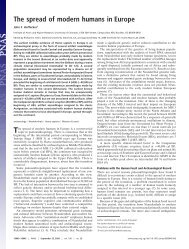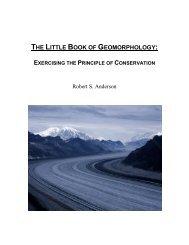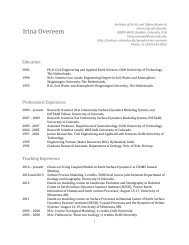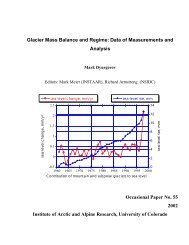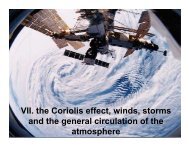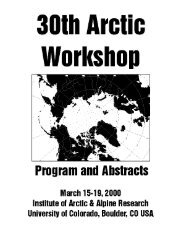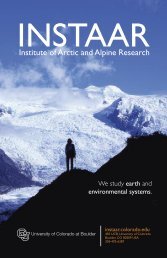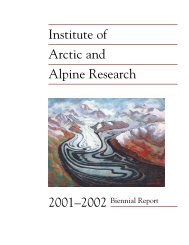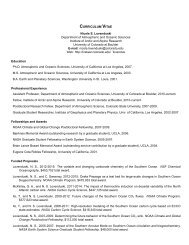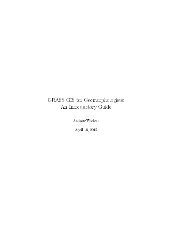The Lost Seal: A Scientific Children’sBook from the Long-Term EcologicalResearch (LTER) ProgramPainting <strong>of</strong> the lost seal beinglifted by a helicopter by Emily <strong>of</strong>Granby Elementary, Worthington,Ohio, 2<strong>00</strong>5–2<strong>00</strong>6. Emily’spainting was part <strong>of</strong> a classroomactivity based on The Lost Seal.Emily wrote, “I drew this picture... because I thought it was coolwhen they scooted it into thetarp without hurting it. And theysaid that the winds were 144miles per hour. WOW, it mustbe cold out there!”Achance encounter between scientists working in theDry Valleys <strong>of</strong> Antarctica and a young Weddell seal isrecounted in the scientific children’s book, The Lost Seal.Diane McKnight and an international team <strong>of</strong> scientistswere working in the Dry Valleys in 1990 when they cameacross a Weddell seal, miles from his natural habitat onMcMurdo Sound. McKnight described the encounter in ahandout for K–12 classroom presentations. With theInternational Polar Year (IPY) approaching, the handout wasrevised and illustrated to become the second book in aseries published by the Long-Term Ecological Research(LTER) Schoolyard Program and Moonlight Publishing, LLC,in collaboration with the NSF, CU Boulder, and Byrd PolarResearch Center at the Ohio State <strong>University</strong>.The Lost Seal is an engaging introduction to the environment<strong>of</strong> the Dry Valleys and is consistent with sciencestandards for 2nd through 5th graders. The story is setwithin the context <strong>of</strong> historical exploration <strong>of</strong> the region,the harsh conditions for life, and ongoing research onhydrology, limnology, and microbial ecology.Illustrated by Dorothy Emerling, The Lost Seal also featuresillustrations and comments by dozens <strong>of</strong> elementaryschool students from countries performing research in theDry Valleys. The story, with footage <strong>of</strong> the seal and photos<strong>of</strong> the Dry Valleys on DVD, was sent to 28 elementaryschool classrooms across Australia, New Zealand, theUnited Kingdom, and the United States.The materials packet served as the basis <strong>of</strong> classroomactivities, and the children’s artwork and comments, 413 inall, were sent back to <strong>INSTAAR</strong>. All the children’s artworkcan be found on The Lost Seal web site (http://www.mcmlter.org/lostseal), along with the materials packet.Once The Lost Seal was completed, sets <strong>of</strong> books were sentto each participating classroom.The Lost Seal links several outreach efforts. Artworkfrom children in four countries emphasizes the internationalnature <strong>of</strong> interest in the Antarctic in a way particularly suitedto the IPY. Creating the artwork became an activity indozens <strong>of</strong> classrooms across these countries, and sets <strong>of</strong>books returned to the classrooms enable future activities.The web site, linked to educational clearinghouses, helpsreach a broad audience <strong>of</strong> K–12 teachers and students.Teachers can link their own classroom activity web sites toThe Lost Seal site. The book is for sale through distributorsto libraries, bookstores, and Internet-based vendors. Ateacher’s guide, which is under development, will be distributedsimilarly and sent to participating classrooms.The success <strong>of</strong> The Lost Seal has helped launch theLTER Schoolyard Series; two more children’s books are indevelopment from different LTER sites.Painting <strong>of</strong> a seal that has justhad a meal by Brandon <strong>of</strong>Leongatha Primary School,Victoria, Australia, 2<strong>00</strong>5–2<strong>00</strong>6.Painting <strong>of</strong> the seal stuck in themountains by Helen <strong>of</strong> CombeDown Primary, Bath, England,2<strong>00</strong>5–2<strong>00</strong>6.Cover <strong>of</strong> The Lost Seal children’s book,with words by Diane McKnight(<strong>INSTAAR</strong>) and illustrations byDorothy Emerling, published in 2<strong>00</strong>6.An encounter between scientists and ayoung Weddell seal in the Dry Valleys<strong>of</strong> Antarctica has inspired the bookand its publication, which coincideswith the International Polar Year (IPY).The book links multiple outreachactivities <strong>of</strong> the McMurdo Dry ValleysLTER project.36 | SOCIETAL MISSION
Outreach SpotlightsUNDERGRADUATE MENTORING:SUNLIGHT’S EFFECT ON AQUATICORGANIC MATTER. UndergraduateCuong Huynh (CU Boulder) is being mentoredby Natalie Mladenov and DianeMcKnight on a project to un<strong>cover</strong> new waysin which sunlight affects aquatic organic matter. Cuong’sefforts are funded by CU Boulder’s Undergraduate ResearchOpportunities Program (UROP) and Bioscience UndergraduateResearch Skills and Training Program (BURST).The main goal is to equip Huynh with an understanding <strong>of</strong>the research methods and skills in analytical and laboratorytechniques, while at the same time answering some interestingresearch questions.Degradation <strong>of</strong> dissolved organic matter (DOM) byultraviolet light—also known as “photobleaching”—cancause complex compounds in vegetation to be brokendown to simpler compounds which are more readily consumedby bacteria. Huynh has been running experimentsusing a high-powered solar simulator to reproduce the process<strong>of</strong> photobleaching with plant leachates and DOM samples.Huynh is also using a new statistical modeling tool inorder to quantify changes in the optical properties <strong>of</strong> DOMas a result <strong>of</strong> photobleaching.This research experience is a stepping stone to Huynh’smain interest: the chemical structure <strong>of</strong> plants and theirmedicinal properties. He plans to present the results <strong>of</strong> hisresearch at an international meeting in 2<strong>00</strong>7—the InternationalAssociation <strong>of</strong> Theoretical and Applied Limnology(SIL2<strong>00</strong>7).<strong>INSTAAR</strong> COLLABORATES ON LOCALWATERSHED CURRICULUM: “MYH 2 O.” Colleen Flanagan, under the direction <strong>of</strong>Diane McKnight, led the development <strong>of</strong> ateacher curriculum guide and resource kit promotingawareness <strong>of</strong> the Boulder and St. Vrainwatersheds. The guide, entitled “My H 2 O,”blends Colorado state educational standards in science, languagearts, geography, and math into activities, educationalgames, story plots, and community action tasks. Theguide’s hands-on, minds-on projects are enhanced by aresource kit that contains supplies necessary to implementeach activity. Copies were distributed to area public andprivate schools in spring 2<strong>00</strong>6, primarily for use in 4th- and5th-grade classrooms. The project was a joint effort by<strong>INSTAAR</strong> and the Niwot Ridge Long-Term EcologicalResearch Program (NWTLTER), with a number <strong>of</strong> collaboratorsin several local school districts and governmentalagencies.The curriculum supplements the children’s book MyWater Comes from the Mountains by Tiffany Fourment,funded by NWTLTER and <strong>INSTAAR</strong> and distributed toBoulder Valley and St. Vrain Valley school districts in 2<strong>00</strong>4.Funding for the curriculum guide was provided by theU.S. Environmental Protection Agency, the CU BoulderOutreach Committee, the City <strong>of</strong> Boulder, and theWatershed Approach to Stream Health (WASH, a partnership<strong>of</strong> communities in Boulder County formed to protectwater quality). Other support came through SchoolyardNWTLTER, connecting the Colorado Front Range communitieswith the alpine systems <strong>of</strong> the mountains, andadministered by <strong>INSTAAR</strong>.GRAD STUDENT PENS EDUCATIONALJOURNAL ABOUT ANTARCTICSCIENCE. Karen Cozzetto was the maincontributor to an educational web site entitled“77 Degrees South,” which showcases the life,times, and research <strong>of</strong> several groups <strong>of</strong> scientistsworking in the largest ice-free region <strong>of</strong> Antarctica:the McMurdo Dry Valleys. Cozzetto’s focus was on theAntarctic “Stream Team,” which studies the hydrology andecology <strong>of</strong> glacial meltwater streams and is managed byDiane McKnight. The website is geared toward middle andhigh school students and presents science and happeningson the southernmost continent in the form <strong>of</strong> fun journalentries with lots <strong>of</strong> photos. Journal topics range from glacierdynamics to diving in ice-<strong>cover</strong>ed lakes for low-light algaephotosynthesis research, from eclipses to the ins and outs<strong>of</strong> helicopter travel, and from the intricacies <strong>of</strong> environmentallymanaging our human waste to the top signs you’vebeen in the field for three months. Most <strong>of</strong> the entries fromthe 2<strong>00</strong>5–2<strong>00</strong>6 field season were by Cozzetto and postedwith the help <strong>of</strong> volunteer web site designer EmmaHernandez (Cozzetto was also the main contributor in2<strong>00</strong>3–2<strong>00</strong>4 and 2<strong>00</strong>2–2<strong>00</strong>3). The site has been viewed bypeople on all seven continents, and several journal entrieshave been selected for inclusion in National ScienceFoundation’s Digital Library for Earth System Education(DLESE). The website is supported and hosted by the NSF’sMcMurdo Dry Valleys Long-Term Ecological Research (LTER)program.Undergraduate Cuong Huynh (CUBoulder) running experiments using ahigh-powered solar simulator to reproducethe process <strong>of</strong> photobleachingwith plant leachates and dissolvedorganic matter samples, Boulder,Colorado, Fall 2<strong>00</strong>6. Huynh is beingmentored by Natalie Mladenov andDiane McKnight (both <strong>INSTAAR</strong>) on aproject to un<strong>cover</strong> new ways in whichsunlight affects aquatic organic matter.Photo: Natalie Mladenov (<strong>INSTAAR</strong>).SOCIETAL MISSION | 37
- Page 1 and 2: INSTAARInstitute of Arctic and Alpi
- Page 3 and 4: BiennialReport2005-2006Institute of
- Page 5 and 6: INSTAAR: An Earth andEnvironmental
- Page 7 and 8: CU-Denver campus where she helped t
- Page 9 and 10: Where in the world is INSTAAR? Acti
- Page 11 and 12: The instrument was deployed on NOAA
- Page 13 and 14: altered by humans over the past 200
- Page 15 and 16: ties. However, manmade reservoirs a
- Page 17 and 18: Arctic WorkshopThe annual Arctic Wo
- Page 19 and 20: Wendy Roth (INSTAAR) explains the p
- Page 21 and 22: camera equipment. These laboratorie
- Page 23 and 24: Research Grants: Fiscal Years2004-2
- Page 25 and 26: Ogilvie, Astrid: NSF. HSD: Human an
- Page 27 and 28: Theses Completed2005Breiter, Nehale
- Page 29 and 30: Gifford MillerGEOL 1060, Global Cha
- Page 31 and 32: Lana Cohen, MS, Atmospheric and Oce
- Page 33 and 34: Trevor Popp, PhD, Geological Scienc
- Page 35 and 36: Societal Outreach andInformal Educa
- Page 37: A group of students from Southern H
- Page 41 and 42: Spotlights: Honors, Awards,and Reco
- Page 43 and 44: TIM SEASTEDT WINS THE 2005PACESETTE
- Page 45 and 46: Structure of hierarchically organiz
- Page 47 and 48: William F. ManleyFellow of INSTAAR.
- Page 49 and 50: Alan R. TownsendFellow and Associat
- Page 51 and 52: GeophysicsEdmund AndrewsChief River
- Page 53 and 54: INSTAAR Visiting Scientists,2005-20
- Page 55 and 56: Chris JarosSupervisor: Diane McKnig
- Page 57 and 58: INSTAAR Noon SeminarsSpring 2005Tad
- Page 59 and 60: Graduate Student TalksSpring 2005Ry
- Page 61 and 62: Journal and BooksArctic, Antarctic,
- Page 63 and 64: Publications2005Adams, P. N., Storl
- Page 65 and 66: “El Nino suppresses Antarctic war
- Page 67 and 68: European settlement of Lake Eyre, S
- Page 69 and 70: tion of Baffin Island, Arctic Canad
- Page 71 and 72: and soil quality for sustainable gr
- Page 73 and 74: Andrews, J. T., Eberl, D. D., and K
- Page 75 and 76: Cleveland C. C., Reed S. C., and To
- Page 77 and 78: and Pierre Y. Julien. Journal of Hy
- Page 79 and 80: Tributaries to the ColoradoRiver th
- Page 81 and 82: Rocchi, S., LeMasurier, W. E., and



